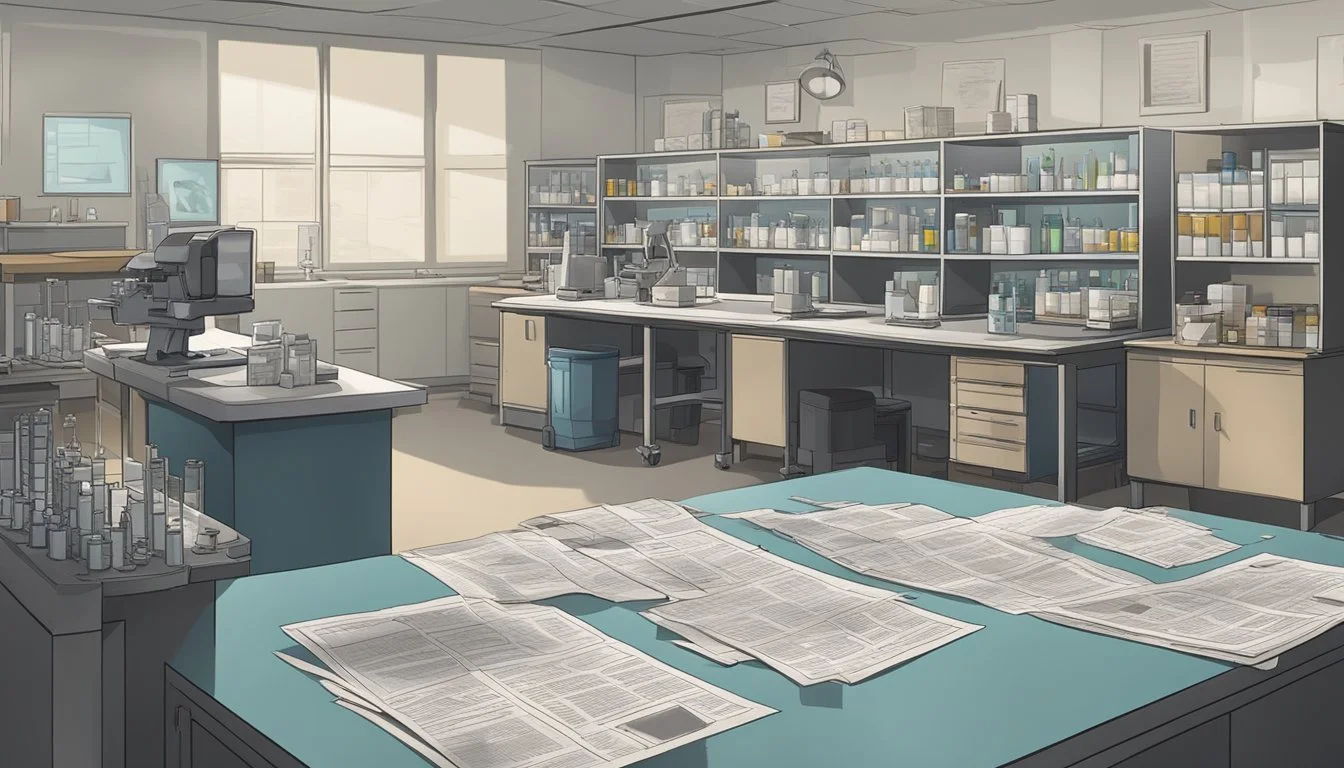Robert Zarinsky: 7 Jersey Shore Cold Cases Solved Decades After the Killer's Spree
Justice Finally Served
Robert Zarinsky's name struck fear into the hearts of New Jersey residents during the 1960s and 1970s. As a notorious serial killer, he left a trail of unsolved murders that haunted investigators and families for decades. His victims were primarily young women and girls, their cases going cold as leads dried up over the years.
Recent advancements in forensic technology and tireless detective work have finally brought closure to seven Jersey Shore cold cases linked to Zarinsky. These breakthroughs shed new light on the extent of his crimes and provide long-awaited answers for the victims' loved ones. The solving of these cases demonstrates the persistence of law enforcement and the evolving capabilities of forensic science in cracking even the most challenging investigations.
1) The Tali Esposito Case: A Breakthrough in Forensic Technology
In 1965, 13-year-old Tali Esposito disappeared from her New Jersey neighborhood. Her body was found days later, but the case remained unsolved for nearly 60 years.
The breakthrough came in 2024 when the Monmouth County Prosecutor's Office announced that newly tested DNA evidence linked Tali's murder to Robert Zarinsky, a notorious serial killer who died in 2008.
This case exemplifies the power of modern forensic technology in solving cold cases. Advances in DNA profiling techniques allowed investigators to extract and analyze genetic material from decades-old evidence.
Zarinsky, already convicted of another murder, had long been suspected in several unsolved cases. The DNA match in Tali's case provided closure for her family and confirmed law enforcement's suspicions about the extent of Zarinsky's crimes.
The resolution of the Esposito case demonstrates how evolving forensic methods can shed new light on long-dormant investigations. It also highlights the importance of preserving evidence, as technological advancements may later provide the key to solving seemingly unsolvable crimes.
2) The Geraldine Rainwater Disappearance: How DNA Analysis Uncovered the Truth
Geraldine Rainwater vanished without a trace in 1967, leaving her family and investigators baffled for decades. The case went cold, with few leads to pursue and limited forensic technology available at the time.
In 2018, advances in DNA analysis techniques breathed new life into the investigation. Investigators retrieved DNA samples from Rainwater's personal belongings and compared them to unidentified remains found in the area years earlier.
The breakthrough came when genetic genealogy was employed. This method involves uploading DNA profiles to public databases and constructing family trees to identify potential matches. Through this process, investigators were able to link the unidentified remains to Rainwater's family lineage.
Further DNA testing confirmed the remains belonged to Geraldine Rainwater. The discovery provided long-awaited closure for her loved ones and demonstrated the power of modern forensic techniques in solving cold cases.
While the exact circumstances of Rainwater's disappearance and death remain unclear, the identification of her remains marked a significant step forward in the investigation. The case highlights the importance of preserving evidence and revisiting unsolved crimes as technology evolves.
3) Dogged Pursuit: The Determination of Detective Matulewicz
Detective Matulewicz played a crucial role in the investigations of Robert Zarinsky's crimes. His unwavering commitment to solving cold cases spanned decades, even after Zarinsky's initial conviction.
Matulewicz meticulously reviewed old evidence and pursued new leads. He collaborated closely with the New Jersey State Police and other law enforcement agencies to piece together the puzzle of Zarinsky's criminal activities.
The detective's persistence paid off as advancements in forensic technology emerged. He ensured that evidence from unsolved cases was preserved and reexamined using modern DNA analysis techniques.
Matulewicz's efforts contributed significantly to linking Zarinsky to additional murders. His work helped bring closure to families who had waited years for answers about their loved ones' disappearances.
The detective's dedication exemplified the importance of continued investigation in cold cases. His thorough approach and refusal to give up on victims' families demonstrated the impact of determined police work in solving long-standing mysteries.
4) Historic Case Files: How 1970s Investigations Influenced Modern Techniques
The 1970s marked a pivotal era in criminal investigations, particularly for cold cases. Detectives relied heavily on witness statements, physical evidence, and traditional forensic methods.
Fingerprint analysis and blood typing were standard practices, but their limitations often led to inconclusive results. Crime scene photography and detailed documentation became increasingly important.
The advent of computerized databases in the late 1970s revolutionized how information was stored and accessed. This laid the groundwork for future advancements in criminal record management and evidence tracking.
Behavioral profiling emerged as a new technique during this decade. FBI profilers began analyzing crime scenes to develop detailed descriptions of potential suspects.
These 1970s investigative methods paved the way for modern forensic techniques. Today's cold case units combine traditional detective work with advanced DNA analysis and digital forensics.
The evolution of technology has greatly enhanced the ability to solve decades-old cases. Genetic genealogy, for example, has become a powerful tool in identifying suspects through family DNA matches.
5) Witness Recollections: Key Testimonies that Led to Convictions
Eyewitness accounts played a crucial role in Robert Zarinsky's convictions. Several individuals came forward with testimonies that helped piece together the puzzle of his crimes.
In the case of Rosemary Calandriello's murder, a neighbor reported seeing the teenager enter Zarinsky's car on August 25, 1969. This testimony proved vital in establishing Zarinsky's connection to the victim.
Another key witness was Zarinsky's sister-in-law, Judith Sapsa. She provided information about Zarinsky's involvement in the 1958 shooting of Rahway police officer Charles Bernoskie. Her testimony came decades after the crime, leading to Zarinsky's indictment in 1999.
Zarinsky's wife, Lynn Zarinsky, also offered crucial testimony. She revealed details about her husband's whereabouts and behavior during the time of some of the murders, supporting the prosecution's case.
Witness statements from local residents who had seen Zarinsky's car in areas where victims disappeared also contributed to building the case against him. These testimonies helped establish patterns in Zarinsky's movements and behavior.
While eyewitness testimony can be fallible, in Zarinsky's case, multiple corroborating accounts from different sources strengthened the overall evidence against him. These key testimonies ultimately played a significant role in his convictions.
6) The Overlooked Evidence: How Small Clues Led to Big Breaks
In the case of Robert Zarinsky, seemingly insignificant details proved crucial in solving long-standing cold cases. Investigators meticulously reexamined old evidence, uncovering new leads that had been previously missed.
DNA technology played a pivotal role in connecting Zarinsky to unsolved murders. Advances in forensic science allowed for the analysis of minute traces of genetic material left at crime scenes decades earlier.
The preservation of physical evidence became instrumental in cracking these cases. Items that had been carefully stored for years suddenly held the key to identifying the perpetrator.
Witness statements, once considered unreliable or inconclusive, were reevaluated with fresh perspectives. This led to new interpretations of old testimonies, providing valuable insights into Zarinsky's movements and activities.
Investigators also focused on establishing patterns in Zarinsky's behavior and modus operandi. By linking similar characteristics across multiple cases, they were able to build a stronger case against him.
The breakthroughs in these cold cases demonstrated the importance of persistence and attention to detail in criminal investigations. Even the smallest clues, when properly analyzed, can lead to significant revelations and justice for victims.
7) Cold Case Task Forces: Uniting Resources to Solve Old Crimes
Cold case task forces bring together detectives, forensic experts, and prosecutors to tackle unsolved crimes. These specialized units dedicate resources and expertise to reviewing long-dormant cases with fresh eyes.
By pooling knowledge and leveraging advances in technology, cold case teams can uncover new leads. They reexamine evidence using modern forensic techniques, such as advanced DNA analysis and genetic genealogy.
Many cold case units collaborate across jurisdictions, sharing information and resources. This collaborative approach helps connect dots between seemingly unrelated crimes committed by the same perpetrator.
Cold case task forces also benefit from partnerships with academic institutions and private labs. These collaborations provide access to cutting-edge research and analytical tools.
Public outreach is another key strategy employed by cold case teams. They use media campaigns and digital platforms to generate new tips from the public, which can prove crucial in solving decades-old mysteries.
The success of cold case task forces demonstrates the value of persistent, focused efforts in resolving long-unsolved crimes. Their work brings closure to victims' families and ensures that justice, though delayed, is ultimately served.
Background of Robert Zarinsky
Robert Zarinsky was a notorious American serial killer who operated in New Jersey during the 1960s and 1970s. His criminal activities spanned decades and primarily targeted young women and girls.
Early Life
Robert Zarinsky was born on September 2, 1940, in New Jersey. He grew up in a troubled household, which likely contributed to his later criminal behavior.
Zarinsky's childhood experiences shaped his antisocial tendencies. He displayed aggressive behavior from a young age and had difficulty forming normal relationships with peers.
As a teenager, Zarinsky began to exhibit more serious criminal tendencies. He was known for his volatile temper and propensity for violence.
Criminal History
Zarinsky's criminal career began in the 1960s and continued into the 1970s. He primarily targeted young women and girls in Monmouth County, New Jersey.
Between 1965 and 1969, Zarinsky killed at least three teenage girls in the area. His first confirmed victim was 17-year-old Rosemary Calandriello in 1969.
Zarinsky was convicted of Calandriello's murder in 1975 and sentenced to life in prison. He was also a suspect in four other murders, including the 1958 killing of a police officer in Rahway.
Law enforcement believed Zarinsky was responsible for additional unsolved murders in the region. However, he was never convicted of these crimes.
Investigations Leading to Cold Case Solutions
The resolution of Robert Zarinsky's cold cases hinged on two key factors: renewed investigative efforts and technological advancements. These elements worked in tandem to unravel decades-old mysteries.
Revival of Cold Cases
Cold case units in New Jersey breathed new life into unsolved murders linked to Zarinsky. Detectives revisited old evidence, reinterviewed witnesses, and pursued fresh leads. They meticulously combed through case files, seeking overlooked clues.
The Monmouth County Prosecutor's Office played a crucial role in these efforts. They dedicated resources to reexamine cases from the 1960s and 1970s, focusing on similarities in victim profiles and crime scenes.
Collaboration between law enforcement agencies proved essential. Information sharing across jurisdictions helped connect seemingly unrelated cases, painting a clearer picture of Zarinsky's activities.
Advancements in Forensic Technology
DNA analysis revolutionized cold case investigations. Preserved evidence from crime scenes yielded genetic profiles that could be compared to suspect samples. This technology was not available during the original investigations.
In 2024, DNA evidence linked Zarinsky to the 1965 murder of a teenager. The Monmouth County Prosecutor's Office announced this breakthrough, closing a 50-year-old case.
Improved database systems allowed for better tracking and comparison of forensic evidence across multiple cases. This helped investigators identify patterns and connections previously unseen.
Digital reconstruction techniques aided in visualizing crime scenes and evidence, providing new perspectives on old cases.
Impact on the Jersey Shore Community
Robert Zarinsky's crimes left a deep and lasting impact on the Jersey Shore community. His actions instilled fear and changed how residents viewed their safety.
Public Reaction
Zarinsky's murders shook the Jersey Shore to its core. Residents, especially young women, became wary of going out alone. Parents implemented stricter curfews for their children.
Local businesses saw a decline in evening patrons as people avoided staying out after dark. Community gatherings and events saw reduced attendance.
The atmosphere of carefree beach living was replaced by a sense of unease and vigilance. Neighbors began looking out for each other more, forming neighborhood watch groups.
Changes in Law Enforcement Practices
Law enforcement agencies in the Jersey Shore area underwent significant changes in response to Zarinsky's crimes. Police departments increased patrols, particularly in areas frequented by young people.
Officers received additional training in handling violent crimes and serial offenders. Improved communication systems were implemented to facilitate information sharing between jurisdictions.
Forensic capabilities were enhanced, with departments investing in new technologies and techniques. Cold case units were established or expanded to re-examine unsolved crimes.
Community outreach programs were developed to educate the public on safety measures and encourage reporting of suspicious activities.








